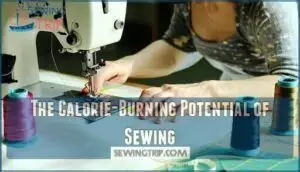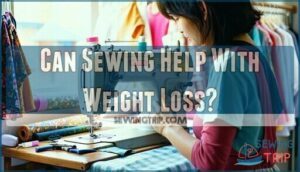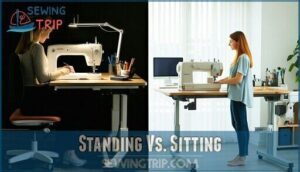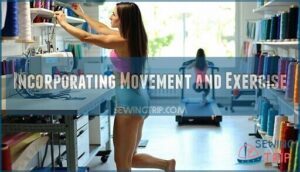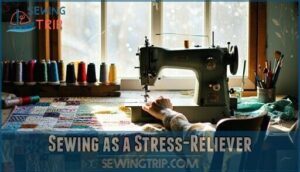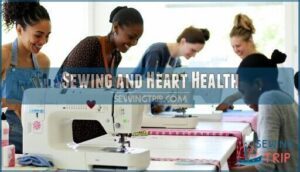This site is supported by our readers. We may earn a commission, at no cost to you, if you purchase through links.

Sitting at your sewing machine isn’t exactly a marathon, but you’ll still burn about 50–100 calories an hour—think of it as the slow cooker of workouts.
If you sneak in a few stretches or march in place between seams, you can easily double that number.
Sure, it’s no spin class, but over time those stitches add up—especially if you’re constantly reaching, pinning, or wrestling with a stubborn hem.
Curious if sewing can help with weight loss or how to make your craft time more active, let’s unravel those threads next to understand the impact of sewing on your physical activity.
Table Of Contents
- Key Takeaways
- Does Sewing Burn Calories?
- The Calorie-Burning Potential of Sewing
- Can Sewing Help With Weight Loss?
- How Many Calories Do You Burn While Sewing?
- Maximizing Calorie Burn While Sewing
- Is Sewing a Good Form of Exercise?
- Sewing and Brain Health
- Sewing as a Stress-Reliever
- Sewing and Heart Health
- The Potential Drawbacks of Sewing as a Physical Activity
- Frequently Asked Questions (FAQs)
- Conclusion
Key Takeaways
- Sewing does burn calories—expect to use about 50–100 calories an hour just sitting, and more if you sneak in movement during your projects.
- You’ll boost your calorie burn by standing, stretching, or adding a few quick exercises while you sew.
- Factors like your weight, session intensity, and whether you hand or machine sew all affect how many calories you’ll burn.
- While sewing isn’t a gym workout, mixing in extra movement during craft time helps chip away at your daily calorie goal.
Does Sewing Burn Calories?
Regarding busting sewing calorie myths, know this—yes, sewing does burn calories! Every time you’re threading that needle or guiding fabric through your machine, you’re clocking in some activity calorie burn.
It mightn’t feel like a workout, but every little bit counts. Simply sitting at your machine has its own sewing MET value, with sewing calories burned adding up to around 50-100 calories per hour, depending on how much you fidget or reach.
But don’t park yourself like a statue! Get creative: stand while cutting, do a few lunges before pinning, or take a dance break when the bobbin runs out. The more you move, the greater your sewing energy expenditure.
So next time you’re measuring fabric, remember—calories in sewing come from more than just your hands.
The Calorie-Burning Potential of Sewing
You might be surprised to learn that sewing isn’t just a creative hobby—it actually burns calories, too.
If you’ve ever found yourself working up a light sweat after wrestling with fabric or chasing a runaway spool, there’s a little science at work behind those busy hands.
Sometimes sewing is a secret workout—wrangling fabric and chasing threads gets your body moving more than you think!
Hand Sewing Vs. Machine Sewing
If you’ve ever zipped through a project with a machine or stitched away by hand, you’ve probably felt the difference in muscle engagement and sewing calorie burn.
Hand sewing uses fine motor skills and tends to burn fewer calories per hour than the speedy machine, but don’t underestimate its physical demands. For example, a 154-pound person can expect to see their calories burned sewing over time.
Try these for fun and extra burn:
- Stand up every half hour.
- Do squats while threading needles.
- Squeeze a stress ball between stitches to increase calorie burn and make the task more engaging, which can be a great way to experience sewing calorie burn.
Factors That Affect Calorie Burn
Let’s stitch together some real talk on sewing calorie burn. Your Body Weight, Fitness Level, gender, and age steer how many calories you use.
Slouching? You’ll burn less. Stand tall and pace yourself—both matter. Even your metabolism throws in a wildcard.
As you age, remember that you may experience age-related muscle loss, which can affect your metabolic rate. Check out how these factors stack up while you’re sewing below:
| Factor | More Burn | Less Burn |
|---|---|---|
| Body Weight | Higher | Lower |
| Fitness Level | Lower | Higher |
| Age/Gender | Men/Young | Women/Older |
Estimating Calorie Burn
With sewing exercise, the real secret to accurate calorie burn estimates lies in knowing your MET value, weight, time at the machine, and how intense you make the session.
Whether standing or sitting, activity intensity and posture matter.
Online tools and simple calculation methods factor in individual factors, letting you see exactly how many calories you’ve burned crafting, down to the last thread of energy expenditure, using your weight and the session’s intensity.
Can Sewing Help With Weight Loss?
If you’re angling for “Sewing Weight Loss,” every stitch and snip can help tip the calorie balance in your favor.
Although you won’t torch calories like a spin class, sewing gives you chances for “Active Sewing Breaks.”
Standing up to cut fabric or stepping away to thread a needle adds movement to your craft, sneaking in calorie burn.
Try weaving in squats or quick stretches between projects—it’s like pressing the refresh button for both body and mind.
The secret sauce? Integrate a little “Sewing Exercise” each session and you’ll foster a steady “Calorie Deficit Sewing,” supporting sustainable weight loss.
Light activity, focus, and creativity blend to make sewing benefits go beyond just finished garments—they help keep your health efforts stitched together for the long haul.
How Many Calories Do You Burn While Sewing?
If you’re looking to shed a few pounds or just boost your daily calorie burn, sewing might surprise you. Whether you’re hand-stitching or manning the machine, the calories burned crafting can add up.
On average, you’ll burn about 58–126 calories per hour, depending on your body weight, the type of sewing, and how intense your session gets. Activity Intensity really matters—throw in some standing or a few stretches, and your tally climbs.
Heavier folks burn more, while lighter people see a smaller drop on the scale, thanks to Weight Impact and Individual Differences.
Here’s why you’ll love sewing calories away:
- It counts as a legitimate calorie burning hobby.
- Small movements add up to meaningful numbers over time.
- Sewing weight loss is gradual, yet totally possible—no gym shoes needed!
So, is sewing exercise? Your calorie tally says yes.
Maximizing Calorie Burn While Sewing
You might be surprised, but you can boost the calories you burn while sewing just by making a few simple changes.
Whether you stand, stretch, or sneak in a few squats between stitches, you’ll keep your body moving and your sewing projects on track.
Standing Vs. Sitting
Switching your sewing spot from chair to feet can actually crank up your calorie burn—think of it as a mini standing desk, but for making masterpieces.
When you stand, your posture impact improves, more muscles kick in, and your circulation benefits get a boost. You’ll notice less fatigue and better energy levels.
Ergonomic sewing means mixing standing and sitting. Many sewers find benefits using a specialized sewing setup.
Here’s a side-by-side look:
| Activity | Calorie Burn |
|---|---|
| Sitting Sewing | Lower |
| Standing Sewing | Higher |
| Muscle Engagement | More |
| Fatigue Levels | Less |
| Circulation | Better |
Incorporating Movement and Exercise
While alternating between sitting and standing, sneak in a few sewing exercises for a quick fitness boost.
Lunge for your scissors or do squats while winding bobbins—your legs will thank you later.
Don’t just sit; weave in active breaks like high knees, wall push-ups, or brisk walks.
Consider using a sewing fitness tracker to monitor your activity.
Embrace movement integration for calorie boosting and discover that sewing exercise turns your crafting into an active hobby.
Using Resistance Tools
While you’re tackling that hem or seam, try using resistance tools like ankle weights or bands for extra sewing exercise.
Push through your heels, focus on slow, controlled movements, and let your glutes get in on the action.
Gradually add weight as you get stronger—it’s all about enhanced muscle engagement and calorie burn.
Implementing line balancing techniques can help optimize your sewing workflow for maximum efficiency.
- Feel the burn, not the bobbin!
- Posture gets a homemade upgrade.
- Balance disc benefits: wobble while you work!
Is Sewing a Good Form of Exercise?
You might be surprised—sewing isn’t just about pressing a foot pedal and threading needles.
It counts as a low-impact activity, burning more calories than zoning out with a TV remote. But is sewing exercise in the gym sense? Not quite.
Think of it as a way to sneak in movement, especially if you add squats, calf raises, or lunges during sewing breaks. These little bursts add to your daily calorie burn and support joint health.
Of course, sewing has physical limitations, so keep your expectations realistic. While it offers sewing health benefits like better hand-eye coordination and posture, it shouldn’t replace complementary exercise or brisk walks.
Use sewing as part of a well-rounded activity plan—enjoy the creative process, reap the sewing energy expenditure perks, and keep your overall fitness in check.
Sewing and Brain Health
After checking how sewing stacks up as exercise, it’s time to peek at what it does upstairs—your brain gets a real workout, too.
Sewing nudges those neurons awake, boosting focus and jumpstarting mental wellbeing.
You’ll find your memory recall ticking along as you steer through patterns, while all that fabric handling turbocharges your fine motor skills.
It’s not just arts and crafts for your hands—think of it as yoga for your gray matter.
Sewing can also provide significant stress relief.
- Keeps your mind sharp
- Enhances problem-solving skills
- Strengthens neurological connections
- Boosts hand-eye coordination
- Supports stress reduction
Sewing as a Stress-Reliever
Just as sewing sharpens your brain, it doubles as a powerful stress reliever.
Let every stitch soothe your mind, as sewing swaps daily worries for moments of calm creativity.
When you’re tangled up in daily worries, Mindful Sewing offers a creative outlet that helps you find your calm.
Focusing on each stitch can nudge those nagging thoughts aside, bringing much-needed relaxation.
The rhythm of needle and thread encourages mindfulness, easing anxiety and promoting mental wellbeing.
There’s a certain magic in feeling fabric, watching patterns take shape, and realizing you’ve crafted something from scratch—talk about therapeutic benefits!
Even the hum of a sewing machine works like a white-noise machine for your nerves.
So, next time life’s chaos tries to pull a fast one, remember: a little sewing can go a long way for stress relief and creativity.
Sewing and Heart Health
If you’re aiming to add a dash of heart health to your daily routine, sewing might be the perfect thread to pull. Besides offering stress relief, it also serves up gentle cardiovascular benefits.
With every stitch, you’re nudging your heart rate just enough for a light “sewing cardio” session. Blood flows more freely as hands stay busy, especially if you build in movement and stand up regularly for a real circulation boost.
Here’s how you can make the most of sewing for heart health:
- Stand and move every 20 minutes to promote better heart rate and blood flow.
- March in place during pinning or take short dance breaks for a mini workout.
- Add a set of gentle stretches between projects to help lower blood pressure.
- Tackle more complex designs to improve concentration and keep your mind sharp.
- Invite friends for a group project—social sewing can lift your mood and support heart health.
With these tweaks, sewing is more than a hobby—it’s a fabric for lifelong cardiovascular health.
The Potential Drawbacks of Sewing as a Physical Activity
Long stitching sessions can quietly stack up some sedentary risks.
Even when you’re busily threading needles or at the sewing machine, it’s a low-intensity, limited cardio workout—closer to gentle wandering than a brisk walk.
Focusing on patterns for hours can spark Repetitive Strain and invite posture problems—think stiff necks, hunched backs, and tight hip flexors.
Your muscles might wave a white flag, heading toward atrophy if you don’t stretch or move around.
Sitting too long can slow blood flow, raising the odds of varicose veins and even blood clots.
Ergonomic tools can help alleviate joint stress.
While creativity is its own reward, the body thrives on more than sedentary activities, so mix in movement for a healthier routine.
Frequently Asked Questions (FAQs)
Does stitching burn calories?
Absolutely, you’ll torch calories while stitching, even if it feels as laid-back as a cat on a windowsill.
Whether you’re hand sewing or using a machine, you’re moving—and every thoughtful stitch quietly chips away at energy stores.
Does sweating help you lose weight?
Sweating might leave you lighter on the bathroom scale, but that’s water weight slipping away, not fat.
Once you rehydrate, those pounds return.
If you want lasting weight loss, focus on burning calories through activity, not just perspiration.
How many calories does a stair climber burn?
You can torch 180 to 260 calories in 30 minutes on a stair climber, depending on your weight and intensity.
It’s like climbing skyscrapers without the elevator—your legs and lungs will thank you later!
What happens if you sweat a lot?
You drip like a melting ice cream on a hot day, losing water and salt.
Drink up, or you’ll feel tired, dizzy, or even crampy.
Think of it as your body’s built-in air conditioner.
Do you burn calories while sewing?
You’re not just threading a needle—you’re actually burning calories while sewing.
Sitting at the machine can use up about 50-100 calories per hour, and if you stand, cut, or move more, you’ll burn even more!
Is sewing a good exercise?
You won’t swap sewing for cardio, but it’s still a light workout—especially if you stand or mix in stretches.
Sewing sharpens your focus, keeps those hands nimble, and burns calories without you even noticing.
How many calories do you burn while hand sewing?
Funny how hand sewing feels relaxing but burns about 63 calories in 30 minutes for a 155-pound person.
It may seem slow as a snail, but every little stitch helps you chip away at those sneaky calories!
Does sawing burn calories?
You mightn’t break a sweat sawing, but you’ll still torch some calories.
Lifting, pushing, and steady movements all add up—think of it as a mini arm workout that sneaks exercise into your DIY adventures.
How does sewing impact hand and finger strength?
Picture your fingers in a tiny gym—each stitch flexes muscles and boosts coordination.
You’ll strengthen grip and dexterity, making everyday tasks easier.
Don’t worry, you won’t turn into the Hulk, just a handier human!
Are certain sewing techniques better for burning calories?
You’ll burn more calories using hand sewing, standing instead of sitting, or mixing in fabric cutting.
Add a few squats or stretch breaks between stitches, and you’ll turn sewing time into a real calorie-burning session.
Conclusion
Stretching, reaching, sewing—each movement counts, each calorie adds up, and yes, can sewing burn calories becomes a fact, not just a question.
While it’s not a substitute for hitting the gym, you’ll keep your body—and your mind—active with every project.
Mix in a few extra steps, a quick arm stretch, or a standing session, and you’ll boost your burn.
So, keep stitching, stay creative, and know your craft time packs a hidden benefit.
- http://golf.procon.org/view.resource.php?resourceID=004786
- http://journals.lww.com/acsm-msse/Fulltext/2000/09001/Compendium_of_Physical_Activities__an_update_of.9.aspx
- https://www.howmany.wiki/calories-burned/Calories-burned_hand+sewing_30_minutes
- https://coolconversion.com/calories-burned/Calorie-Calculator-%7C-_machine-sewing_
- https://www.sciencedirect.com/science/article/abs/pii/027153179500047M

